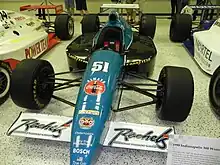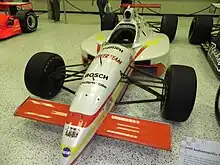 | |
| Category | Indy Racing League |
|---|---|
| Constructor | Dallara |
| Successor | Dallara IR-00 |
| Technical specifications | |
| Chassis | Carbon fiber monocoque with honeycomb structure |
| Suspension (front) | double wishbones, pull rod actuated coil springs over shock absorbers |
| Suspension (rear) | double wishbones, pull rod actuated coil springs over shock absorbers |
| Length | 192–196 in (4,877–4,978 mm) |
| Width | 77.5–78.5 in (1,968–1,994 mm) minimum (Road/Street) |
| Wheelbase | 118–122 in (2,997–3,099 mm) |
| Engine | Infiniti Oldsmobile 4.0 L (244 cu in) 90° N/A V8 DOHC with 4-stroke piston Otto cycle mid-engined, longitudinally-mounted |
| Transmission | Emco EGB-16 6-speed sequential |
| Power | ~ 700–750 hp (522–559 kW) |
| Weight | 1,550 lb (703 kg) |
| Fuel | 100% methanol |
| Lubricants | Various per teams |
| Tyres | Firestone Firehawk |
| Competition history | |
| Debut | 1997 Indy 200 at Walt Disney World |

1999 Indianapolis 500-winning car of Kenny Bräck.
The Dallara IR-7, and its evolutions, the Dallara IR-8 and Dallara IR-9, are open-wheel formula racing cars, designed, developed, and produced by Italian manufacturer Dallara for use in the IndyCar one-make spec-series, between 1997 and 1999.[2]
References
- ↑ "Dallara IR-8". Retrieved 6 November 2022.
- ↑ "1997 Dallara IR7". conceptcarz.com.
External links
This article is issued from Wikipedia. The text is licensed under Creative Commons - Attribution - Sharealike. Additional terms may apply for the media files.